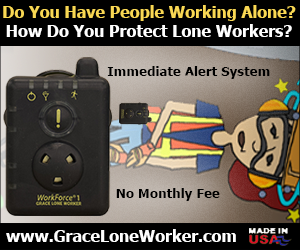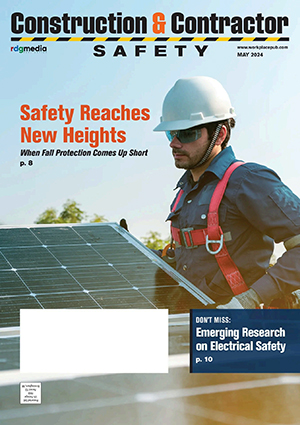OSHA 1915.84: Safeguard Your Lone Workers
“A lot can happen between check-in times; employers who satisfy OSHA 1915.51 with a “time-based check-in” system often tell us that check-in systems do not work and find a Grace Lone Worker “immediate notification” system to be more effective. Grace Lone Worker Pendants are relied upon to automatically transmit a distress alarm when an employee is incapacitated and unable summon assistance on their own. And, it removes the wait between expected check-in times.” Grace Industries, www.graceloneworker.com, 724-962-9231
Background & History
 “OSHA 1915.84: Working Alone” is a regulation that requires employers to account for each employee working alone, throughout each work shift, at regular intervals appropriate to the job assignment, to ensure the employee’s safety and health. This regulation applies to employees working alone in confined spaces or isolated locations.
“OSHA 1915.84: Working Alone” is a regulation that requires employers to account for each employee working alone, throughout each work shift, at regular intervals appropriate to the job assignment, to ensure the employee’s safety and health. This regulation applies to employees working alone in confined spaces or isolated locations.
OSHA defines a lone worker as “an employee working alone, such as in a confined space or isolated location.” Under OSHA’s 1915.84, whenever a worker is doing their job alone, “such as in a confined space or isolated location, the employer shall account for each employee” regularly throughout their shift via some form of communication.
All employers have an inherent duty to protect all workers—including those who work remotely or are isolated. Being a lone worker doesn’t just mean being on a distant worksite, a confined space or not being within other employees’ earshot, however. It can also include remote office work, traveling alone or being on a night shift by oneself. It can mean working without being under direct supervision (i.e., not necessarily “working alone”); it can also include a worker who will be in isolation for any given time period.
Importance of Standard
More people work alone than ever before. Berg Insight reports there are 53 million lone workers in the U.S., Canada and Europe combined, which is about 15% of the overall workforce. The International Data Corporation (IDC) estimates that approximately 1.3 billion people worldwide are mobile workers, many of whom work alone continuously or at various times during their workday.
People working in field operations who work alone face different risks than those who work with a team. It’s essential to recognize what those risks are and to implement control measures to mitigate those risks. The goal of any lone worker program is to prevent workers from going undetected if they become incapacitated or trapped in the field and are unable to summon help.
Anticipating lone worker risks is therefore imperative for employers. Controlling the unique hazards workers face can help mitigate risk and prevent serious injury.
Specific Type of Lone Worker: Confined Spaces
 OSHA defines a confined space as a work area large enough for the worker to enter and perform tasks, but one that it is not designed for people. Specifically, says OSHA, a confined space “also has limited or restricted means for entry or exit and is not designed for continuous occupancy.”
OSHA defines a confined space as a work area large enough for the worker to enter and perform tasks, but one that it is not designed for people. Specifically, says OSHA, a confined space “also has limited or restricted means for entry or exit and is not designed for continuous occupancy.”
People who work in confined spaces come from a wide range of industries. According to the U.S. Bureau of Labor Statistics, from 2011-2018, the top five occupations with the most confined spaces-
related deaths were:
- Construction laborers
- Farmers, ranchers and other agricultural employees
- First-line supervisors of construction trades and extraction workers
- Plumbers, pipefitters and steamfitters
- Farmworkers and laborers for crops, nurseries and greenhouses
The deadly incidents ranged from falling, trench collapses, harmful substance inhalation, as well as fire and explosions.
WHAT TO KNOW: Compliance Requirements
The standard reads as follows:
“(a) Except as provided in § 1915.51(c)(3) of this part, whenever an employee is working alone, such as in a confined space or isolated location, the employer shall account for each employee:
(1) Throughout each work shift at regular intervals appropriate to the job assignment to ensure the employee’s safety and health; and (2) At the end of the job assignment or at the end of the work shift, whichever occurs first.
(b) The employer shall account for each employee by sight or verbal communication.”
Risk Assessment
An important step to determining whether employees are safe to work alone is carrying out a risk assessment for each employee/environment. If the risks identified are too high or not able to be controlled, an employer should not allow employees to work alone under any circumstance. However, if steps can be taken to reduce risks, in line with legislation, employees can work alone. This is where a good lone worker policy becomes essential.
Lone Worker Policies
A lone worker policy is a guide that sets out a companies’ rules on working alone; it can also assist employees in understanding the risks of working alone or remotely. A good lone worker policy also provides workers with instruction and advice on how to safely do their jobs. Further, it is a good idea to conduct inspections to ensure that safe lone worker practices are being implemented and followed properly.
Resources:
- OSHA website: https://www.osha.gov/laws-regs/regulations/standardnumber/1915/1915.84
- Industrial Hygiene in the Workplace has covered many aspects of lone and remote worker safety throughout the past few years. Here is a small sampling:
- “OSHA’s General Duty Clause & Lone Worker Safety:” https://bit.ly/3NyGOHu
- “The Biggest Safety Hazard Threatening Lone Workers:” https://bit.ly/43u26w1
- “Keeping Lone Workers Safe:” https://bit.ly/44y3w9r
- “Four Problems Lone Workers Face and How to Solve Them:” https://bit.ly/3rfGYfx
Share on Socials!
Best Practices to Clean, Sanitize & Disinfect the Workplace
A More Effective Silica Exposure Monitoring Approach
Custom-Molded Hearing Protection in Hearing Conservation Programs
Leaders in Industrial Hygiene
Council for Accreditation in Occupational Hearing Conservation (CAOHC)
Subscribe!
Sign up to receive our industry publications for FREE!











